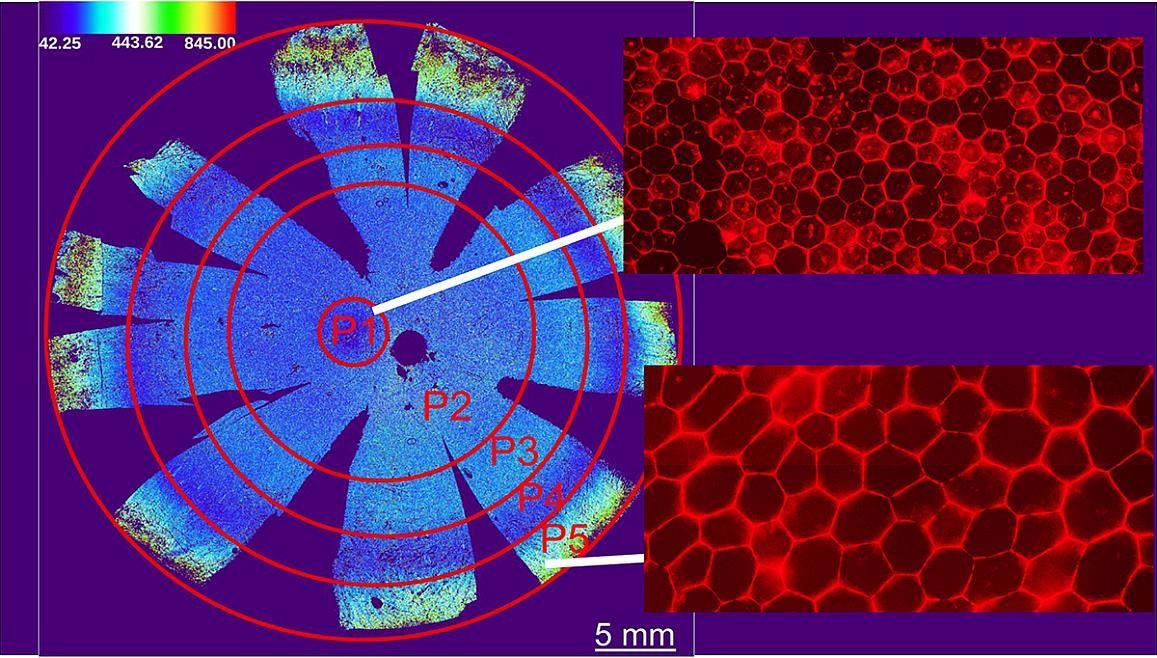Scientists have observed unique variances among the cells that make up a retinal tissue that is critical to human vision. The National Eye Institute (NEI) revealed five different types of retinal pigment epithelium (RPE), a layer of tissue that feeds and sustains the retina’s light-sensing photoreceptors.
 Five subpopulations of RPE (P1-P5) were identified based on cell area, aspect ratio, hexagonality, and a number of neighbors. Foveal RPE (P1) are tightly packed hexagons. Peripheral RPE (P5) is spread out. Image Credit: Davide Ortolan, Ph.D.
Five subpopulations of RPE (P1-P5) were identified based on cell area, aspect ratio, hexagonality, and a number of neighbors. Foveal RPE (P1) are tightly packed hexagons. Peripheral RPE (P5) is spread out. Image Credit: Davide Ortolan, Ph.D.
The researchers used artificial intelligence to evaluate RPE pictures at single-cell resolution to produce a reference map that pinpoints each subpopulation within the eye. The study was published in the journal Proceedings of the National Academy of Sciences.
These results provide a first-of-its-kind framework for understanding different RPE cell subpopulations and their vulnerability to retinal diseases, and for developing targeted therapies to treat them.”
Michael F. Chiang, MD, Director, National Eye Institute
“The findings will help us develop more precise cell and gene therapies for specific degenerative eye diseases,” said the study’s lead investigator, Kapil Bharti, PhD, who leads the NEI Ocular and Stem Cell Translational Research Section.
The rod and cone photoreceptors that comprise the retina in the back of the eye are where vision commences. When photoreceptors are active, they send signals to a complex network of additional retinal neurons, which converge at the optic nerve before traveling to various brain centers. The RPE is a monolayer that resides one cell deep underneath the photoreceptors.
RPE cells’ metabolism can vary with age and disease, leading to photoreceptor degradation. The effect of these RPE modifications on vision varies greatly depending on the intensity and location of the RPE cells inside the retina.
Late-onset retinal degeneration (L-ORD), for example, mostly affects the peripheral retina and, as a result, peripheral vision. The RPE cells of the macula, which are critical for central vision, are largely affected by age-related macular degeneration (AMD), a primary cause of visual loss.
Bharti and colleagues wanted to see if there are multiple RPE subpopulations that could explain the large range of phenotypes seen in retinal illness.
The researchers analyzed RPE cell morphometry, or the exterior form and size of each cell, using artificial intelligence (AI). They taught a computer to assess the full human RPE monolayer from nine cadaver donors with no history of severe eye illness using fluorescently labeled RPE pictures.
Morphometry characteristics were determined for each RPE cell—on average, 2.8 million cells per donor were evaluated—in all 47.6 million cells analyzed. The area, aspect ratio (width to height), hexagonality, and the number of neighbors of each cell were all considered by the method. Previous research has linked RPE function to the tightness of cellular connections, with the more crowded the junctions, the better for showing cellular health.
Researchers found five different RPE cell subpopulations, designated to as P1-P5, clustered in concentric circles around the fovea, which is the most light-sensitive part of the retina, using morphometry. Foveal RPE are completely hexagonal and more compactly placed than RPE in the periphery, with a higher number of adjacent cells.
Surprisingly, researchers detected a ring of RPE cells (P4) in the peripheral retina with a cell area identical to RPE in and around the macula.
The presence of the P4 subpopulation highlights the diversity within the retinal periphery, suggesting that there could be functional differences among RPE that we are currently unaware of. Future studies are needed to help us understand the role of this subpopulation.”
Davide Ortolan, PhD, Study First Author and Research Fellow, Ocular and Stem Cell Translational Research Section, National Eye Institute
Researchers then looked at RPE from cadavers with AMD. Due to disease damage, foveal (P1), RPE was often absent, and differences between cells in the P2-P5 subpopulations were not statically important. In comparison to RPE cells that were not impacted by AMD, the AMD RPE subpopulations tended to be prolonged.
Scientists studied ultrawide-field fundus autofluorescence pictures from patients with choroideremia, L-ORD, or a retinal degeneration with no known molecular origin to further investigate the concept that distinct retinal degenerations affect specific RPE subpopulations.
Despite the fact that these experiments were conducted at a particular point in time, they showed that various RPE subpopulations are susceptible to different forms of retinal degenerative disorders.
“Overall, the results suggest that AI can detect changes of RPE cell morphometry prior to the development of visibly apparent degeneration,” said Ortolan.
Age-related morphometric alterations may also manifest in some RPE subpopulations before they manifest in others. These findings will aid future research employing noninvasive imaging technologies like adaptive optics, which can resolve retinal cells in extraordinary detail and could be used to anticipate changes in RPE health in living patients.
Map of RPE in human eye
Researchers have identified distinct differences among the cells comprising a tissue in the retina that is vital to human visual perception. The scientists from the National Eye Institute (NEI) discovered five subpopulations of retinal pigment epithelium (RPE)—a layer of tissue that nourishes and supports the retina’s light-sensing photoreceptors. Using artificial intelligence, the researchers analyzed images of RPE at single-cell resolution to create a reference map that locates each subpopulation within the eye. A report on the research published in Proceedings of the National Academy of Sciences. Video Credit: National Institutes of Health (NIH)
Source:
Journal reference:
Ortolan, D., et al. (2022) Single-cell–resolution map of human retinal pigment epithelium helps discover subpopulations with differential disease sensitivity. Proceedings of the National Academy of Sciences. doi.org/10.1073/pnas.2117553119.